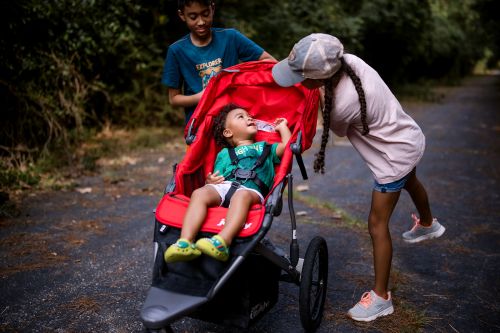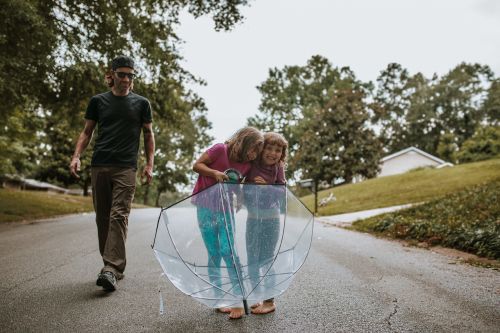10 Ways to Combine Nature and Virtual Learning
- Blog 10 Ways to Combine Nature and Virtual Learning
School in the time of Covid-19 has certainly created many new challenges. While everyone is doing their best to give children a good education during this trying time, children, parents, and teachers are also struggling. With school closures came the rise in virtual learning, even among our youngest school-aged children. Parents and their children are juggling multiple virtual learning meetings, which often leads to more screen time and less outdoor time than children are used to. Luckily, there are ways to combine nature and virtual learning. The benefits of nature are well researched and countless studies have shown nature’s physical and mental health benefits. The benefits happen if you sit, lay, or walk around outside and include:
- Reducing stress
- Increasing memory, creativity, and immunity
- Boosting energy levels and physical activity
 Photo by Krystal Weir Photography
Photo by Krystal Weir Photography
10 Ways to Combine Nature and Virtual Learning
Take the computer outside
If possible, this is one easy way to get your kids outside during the virtual learning part of their day. Set up a picnic blanket, a table and chairs, or just let them lie down in the grass. Being outside has many documented benefits and will likely increase focus once they adjust to their new learning environment.
Let natural air and light into the virtual learning space
Can’t get outside? Don’t worry! You can also let the fresh air and natural light into your learning space by opening a window. If your learning space isn’t next to a window, consider trying to rearrange things while virtual learning is the norm in your home.
Include nature objects as manipulables Children learn best by using their senses, so using nature items in their learning will not only allow them to engage with nature, it will also help them master skills too. Manipulables are great for visualizing math problems, learning to form letters and numbers, forming shapes, counting, and so much more.
Use dirt or sand on a tray (or in its natural environment) for writing
Did you know dirt and sand make excellent erasable surfaces? They are great for practicing writing, math problems, and so much more. Plus it saves on paper and can be done during virtual learning or while practicing the weekly virtual learning topics.
Go for a family walk during online learning breaks

Each virtual learning session has some sort of break time. Use this time to get your kids outside to burn off some energy before returning to their learning activities. Do your kids have different break times? Consider taking everyone outside and for those not on break, setting up their virtual learning area outside for a while.
Read nature-themed books together
Can't get outside? Bring the outside indoors with books. Let kids explore redwoods, the ocean, animals, plants, and so much more with books. Use break time, bedtime, lunchtime, or any other free time to read together.
Use nature objects for art projects
Collect some leaves, pine needles, bark, sticks, acorns, and any other nature objects to create art with. Are your kids learning about volcanoes? Use sticks and red autumn leaves to create a volcano art piece. Are they learning about animal life cycles? Use leaves dipped in paint to make caterpillar and butterfly prints. Don't have time to plan something to tie it to their learning? Don't worry! Kids are incredibly creative, just provide the nature objects, glue, scissors, markers, and tape and see what they come up with.
Eat snacks and other meals outside
All distance learning has scheduled breaks. Use the opportunity to squeeze in some outdoor time with your kids. Set up a picnic for lunch or a grab and go snack so they can roam while they munch.
Provide nature objects for exploration during virtual learning
Many kids learn better while fiddling with something in their hands. Provide an array of nature objects to keep your kiddos hands busy while they sit in their virtual learning space. They may choose to spin, touch, smell, roll, toss between their hands, stack, smash, and do so much more. All may help them stay focused on their screens too, even when it isn't obvious they are.
Make nature sensory jars
Gather some colorful nature objects, shove them into an empty see-through water bottle, dish soap bottle, Mason jar, etc., add water, and secure the lid. Viola, you've created a nature jar that kids can fiddle with while learning. Flowers, flower petals, leaves, small sticks, small pebbles, acorns, pine needles, and so much more can be used. Check out the Niños and Nature blog for more details.
These are just a few ideas. There are many other ways to incorporate nature into your daily or weekly virtual learning rhythm.
How are you including nature in your virtual learning?
Looking for more information? Here are some other Hike it Baby posts that may be helpful.
13 Books that Help you Bring Nature into Your Child’s Education
Nature-Rich Resources for Distance Learning and Homeschooling
9 Diverse Children's Nature Books to Add to Your Collection
ABOUT HIKE IT BABY
Hike it Baby is a 501(c)(3) non-profit organization dedicated to getting families outdoors and on trails across the U.S. and internationally, supporting, educating and inspiring families through their more than 300 communities across North America. Since its grassroots inception in 2013 in Portland, Oregon, Hike it Baby is now a growing community of 270,000 families and 500 volunteer branch ambassadors hosting more than 1,600 hikes per month. More information, as well as daily hike schedules, can be found at HikeitBaby.com, Facebook, YouTube, Pinterest, and Instagram.
Related Content





Comments